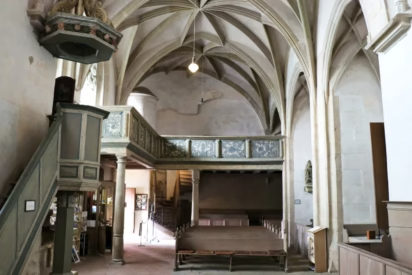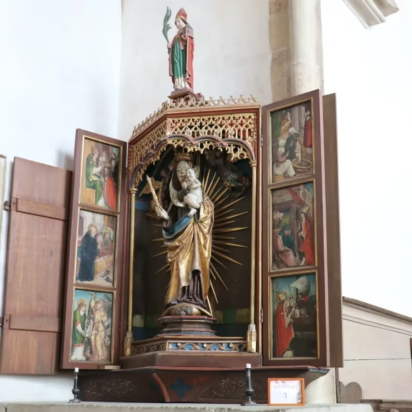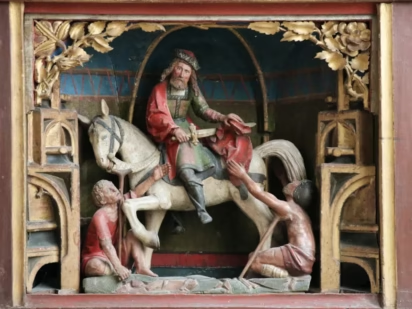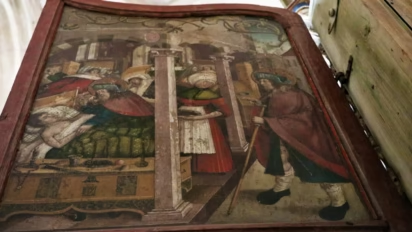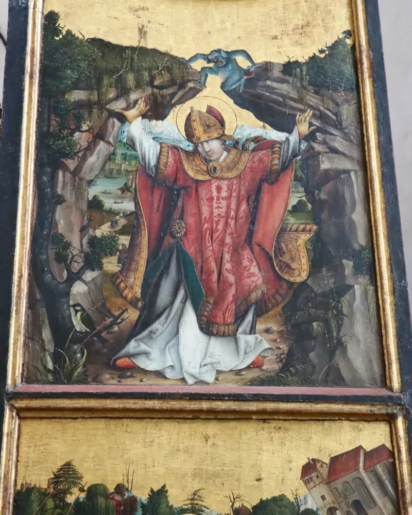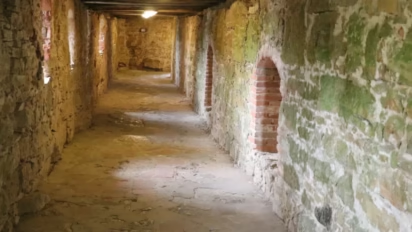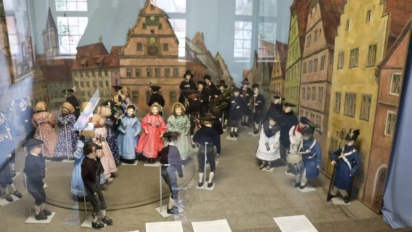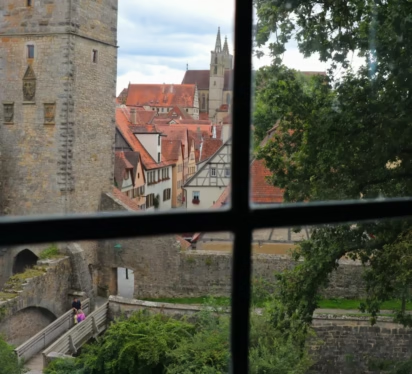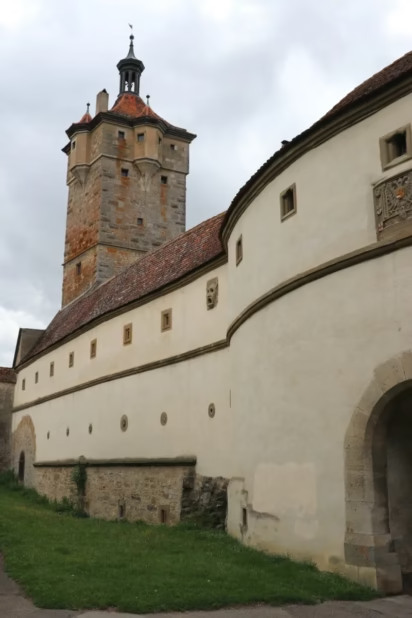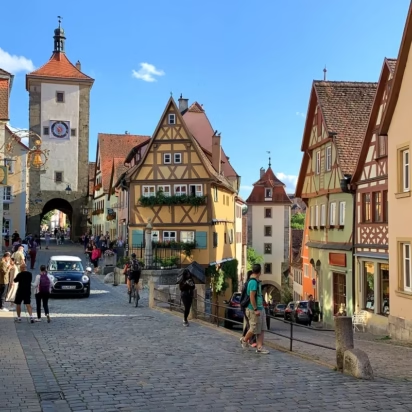Visit the St Wolfgangskirche in Rothenburg ob der Tauber to see a medieval fortress church (Wehrkirche) in the Klingen Bastion.

The St Wolfgangskirche (Church of St Wolfgang) in Rothenburg ob der Tauber is a Late Gothic fortress church (Wehrkirche) constructed as an integral part of the town defenses. It forms part of the Klingenbastei (Klingen Bastion) in the northwestern corner of the medieval town. A road — still in use by cars today — runs under part of the church and then through the Klingentor into the old town. Three altars are the main artworks inside the church but the architectural oddities of the building are generally of more interest. The Wolfgangskirche is a minor sight on the Romantic Road but well worth seeing when in Rothenburg ob der Tauber.
Visit St. Wolfgangskirche in Rothenburg

The Late Gothic St Wolfgangskirche was erected between 1475 and 1493 by the brotherhood of shepherds and is thus also known as the Shepherds’ Church (Schäferskirche). It formed part of the bastion guarding the northern entrance into Rothenburg — the underground casemates and rampart in the loft may still be accessed from inside the church.
When viewed from the Klingentor gate, the most interesting part of the Wolfgangskirche is actually not really part of the church at all. It is the half-timbered Torwächterhaus (Sentries’ House), which is now visited from inside the church, built over an access gate in the former bastion.
In the Middle Ages, a wooden drawbridge, rather than the present stone bridge, would have passed over the moat to the countryside. The shafts for guiding the portcullis may still be seen in the stonework of the gate.
Interior of the Wolfgangskirche
The architectural oddity of the Wolfgangskirche is probably the best reason to visit this small church. The church is typically Gothic but it has two unusual additions: behind the main altar is an entrance to the casemates while from the back of the church, it is possible to enter the former Sentries’ House and the ramparts of the Klingen Bastion.
The interior of the small chapel is dominated by three altarpieces created around 1500. The paintings are mostly by a local artist, Wilhelm Ziegler. The sculptors are mostly unknown but could have been from the studio or pupils of Riemenschneider but clearly not by the master himself. Real Tilman Riemenschneider quality as may be seen in the nearby St.-Jakobs-Kirche, the St Peter and St Paul Church in the small village Detwang, or in the Herrgottskirche in Creglingen.

Marienaltar (Altar of the Virgin)
The Marienaltar (Altar of the Virgin) is the oldest of the altars in the Wolfgangskirche with the main statue of the Virgin with Child dating from around 1480-90, while the statue of St Wolfgang on top is from around 1470.
The wings are by Wilhelm Ziegler — his WZ and 1515 appear on both wings that illustrate scenes from the lives of Holy Roman Emperor Heinrich II (Henry II), who was declared a saint, and St Nicolaus. Note the imperial eagle and the city emblem of Rothenburg in the detailing. These wings were originally used in the Wendelin altar — they are too narrow to enclose the Mary statue of this altar.
Wendelinaltar
The Wendelin Altar is dedicated to St Wendelin but the paintings of his life are on the outside of the altar wing doors and thus rarely seen. Although the statues might be by followers or Riemenschneider, they are clearly not of the quality of the master himself.
The main statue is of St Wendelin, who is venerated as the patron saint of pilgrims and herdsmen. On the left is St Nicolaus and on the right St Henry. On the predella is St Martin sharing his coat with the beggar — St Martin is the patron saint of Germany (and France and Zillis amongst others).
Wolfgangsaltar

The main altar is dedicated to St Wolfgang, the patron saint of shepherds. On his left is St Sebastian and on his right St Rochus. Scenes from the lives of these two saints are painted on the outside of the altar wings. They were amongst others seen as protectors against the plague and other diseases and thus frequently invoked during much of the Middle Ages. The painting of St Roch visiting a hospital is considered the oldest depiction of a plague hospice in the German-speaking world.
The paintings on the inside of the wings are scenes from the life of St Wolfgang. Note top right how the saint keeps two mountains in position despite the attempt of a devil to push the rocks down. There are some remarkable fine details in the background too.
The small chapel (in the bottom right) is the St Wolfgang’s Church in Rothenburg — according to legend, a small chapel tried to follow the saint when he moved away and only remained on its foundations when ordered by the saint to stay.
On the predella is a depiction of the way to Golgotha — Christ stumbles under the load of the cross.
The paintings on the altar are by Wilhelm Ziegler and dated to 1514. The main sculptures are possible from the workshop of Riemenschneider.
Casemates of the Wehrkirche
A small door to the left of the main altar opens onto a stone staircase that visitors may follow into the casemates of the Klingen Bastion. There is not much to see here but still worth a quick look to remind why this is a fortress church (Wehrkirche).
The angles of the narrow openings for gun emplacements and divisions into smaller dungeons hint at the original defensive purposed of these structures. Some of the chambers here have a height of nearly 5 m.
The most interesting part of the cellars is no longer accessible — a secret passage that during sieges could allow access to the forest from the church (and town).
Sentries’ House and Ramparts
Going put the stairs next to the church entrance is more interesting. These stairs lead to the former sentries’ house and the ramparts.
The Sentries House now has a small exhibition on shepherding and the Schäferstanz (Shepherds’ Dance) that is still performed according to tradition on Rothenburg’s market square on Whit Sunday. The exhibition opened in 1986 and appears unaltered since — many may find the view through the window towards old town Rothenburg more interesting.
The staircase also gives access to the ramparts on the Northern side of the church. The views from the ramparts are away from the old town but a few historic photos here are interesting. Several show the damage done in the air raid of 31 March 1945 that killed 39 and destroyed 306 homes, 750 m of the town walls, and 9 towers.
Also interesting to see a machicolation from the inside — the German Pechnase literally means “pitch nose.” However, when seen from outside the town, it is obvious that this face machicolation is not original, as it is positioned off-center rather than directly over the gate.
Visitor Information St. Wolfgangskirche in Rothenburg
The Wolfgang’s Church is usually open on weekends from April to October, daily in August, and on most national and Bavarian holidays. The church is closed on Tuesdays.
Opening times are generally from 9:30 to 17:00 but Sundays from 10:00 – 13:00 and 13:30 to 16:30.
Admission is €3.
A folder in various languages is available with detailed descriptions of the art and some other features worth exploring in the church.
Although the interior is worth seeing, it is clearly not of the same standard as say the St.-Jakobs-Kirche. Travelers failing to visit the interior may enjoy the outside for free. This is the most interesting part of this little church with a romantic setting in the remaining part of the Klingenbastei.
It is possible to walk on the covered sentries walk on the ramparts of Rothenburg ob der Tauber for 2.4 km from the Klingentor all the way to the mighty Spitalbastei in the south of the town.
More on Rothenburg ob der Tauber
For more on the Rothenburg ob der Tauber and nearby sights on the Romantic Road:
- Top Sights on the Romantische Straße with Romantic Road Map
- Walk on the Ramparts and Sentry Walk on the Wall of Rothenburg
- Visit the St.-Jakobs-Kirche (St James Church) with the Tilman Riemenschneider Holy Blood Altar
- Visit the Medieval Crime Museum
- Visit the Wolfgang’s Church in the Klingenbastei
- See the Herrgottskirche with Tilman Riemenschneider Altar of the Virgin in nearby Creglingen
- Transportation to Rothenburg ob der Tauber – Driving or Take the Train
- Bus Day-Trip Tours are often available from Frankfurt or Munich.
- Hotel prices in Rothenburg are surprisingly reasonable, except over weekends.
- Save with the Bayern-Ticket on Train Transportation in Bavaria
- Get online quotations for taxis and airport shuttles from Frankfurt or Munich airports.
